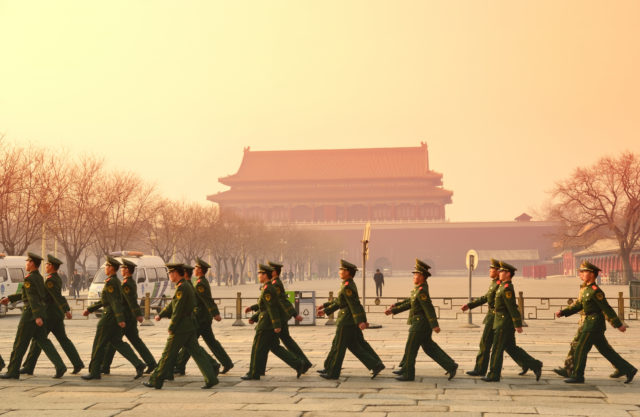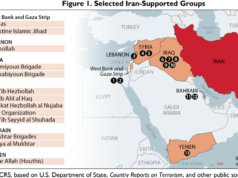China’s rise is the greatest threat to U.S. security, interests, and values since the Cold War. Its aggressions include breaching international law to tighten control over Hong Kong, disputes with Japan, Taiwan, India, Vietnam, the Philippines, Malaysia and other countries, and terraforming and militarization in disputed waters in the South China Sea.
China’s leadership sees the U.S. as an enemy to be overcome on the path to global domination. Chinese military documents suggest a primary strategic goal to capture Taiwan. A high-ranking Chinese general warned that China will militarily conquer Taiwan if it cannot dominate it by other means.
China spends four times more than Russia on its military. U.S. allies in Asia spend half of what its European allies spend on their defense. The military threat from China to its region is much greater than the sizable threat that Russia poses in Europe, while China’s economic ability to carry out sustained action far outpaces Russia’s.
China is conducting the largest military expansion and modernization in its history. Its defense spending rose by 85 percent from 2010-2019 while U.S. defense spending fell by 15 percent in the same period. Adjusting for labor costs, China’s defense budget in 2017 was $467.4 billion. Considering its less logistically demanding mission and lower personnel costs, China’s defense spending closely rivals the U.S.
Why Compete?
China is the only country with the economic and technological base to build a military capable of competing with the U.S. globally. Its leader wants a military capable of defeating the U.S. by 2050. It is already stronger than Russia in virtually every respect other than its nuclear arsenal. Through espionage, it has achieved parity and beyond on critical capabilities like quantum computing, hypersonic weapons, and artificial intelligence.
As China rises, the international power structure mirrors historical moments of violent transition. The belief that international institutions can forestall conflict has dominated American foreign policy discourse in recent decades. In reality, illiberal regimes have captured and used institutions to advance their own agendas and accrue power, none more adeptly than China. The devastating impact of China’s capture of the WHO in the wake of COVID-19, exposes the folly of outsized reliance on international bodies.
As the U.S. deliberates a more confrontational policy towards China, it should answer three questions:
Is China poised to overtake the U.S. in economic and military power?
Will China use its superiority to expand at the expense of the U.S.?
Is PRC global leadership something that the U.S. can abide, comparable to Great Britain peacefully ceding global preeminence to the U.S. during and after World War II?
The answers to the first two questions are clearly yes. China’s power is rising faster than American power, although the rate depends on complex factors, including how the U.S. chooses to compete. China intends to abrogate long-standing treaties, by force if need be. Regarding the third question, U.S. security and the global order that undergirds the American way of life depend upon U.S. power. Because China is rising, intends to overturn the world order, and this threatens vital U.S. interests, the U.S. faces a Cold War with China and it must compete to win.
America is Unprepared
The Cold War was ultimately decided by greatly superior U.S. economic strength which the USSR. could not match. Not so for China.
Unlike currently with China, during the Cold War there was minimal interconnectivity between the U.S. and its rival. The U.S. did not rely on the USSR for inputs critical to its defense and healthcare. Allied communications were not conducted over Soviet telecommunications infrastructure. Hundreds of thousands of Soviets were not studying physics, chemistry, biology, and engineering in U.S. universities. The USSR lacked the leverage to coerce American businesses and news and entertainment media to self-censor. Moscow did not hold vast quantities of U.S. sovereign debt. Finally, the “Iron Curtain” that separated the U.S. from the Soviet Union is more like a one-way mirror for China. China can access U.S. institutions, while selectively closing its population to American influence.
Post-Cold War triumphalism partially explains the failure to compete. American political scientist Francis Fukayama referred to the U.S.-led post-Cold War order as “the end of history,” capped by the global spread of capitalism and democracy. But China, led by its Communist Party, rose with astonishing speed. In 2000, its GDP was less than 12.5 percent of America’s. By 2014, China had overtaken the U.S. as the world’s largest economy on a Purchasing Power Parity basis.
The U.S. recognized the USSR as a strategic rival early on, even as it allied with it against Nazi Germany. In 1946, U.S. diplomat George Kennan articulated this in his “long telegram” from Moscow to the State Department. Kennan’s views, summarized as “containment” of the Soviet Union, became the cornerstone of U.S. foreign policy for the next five decades. It dominated diplomacy, defense, economic competition, and even popular culture. There is no parallel for China. There is no anti-PRC equivalent to the anti-Soviet series U.S. television cartoon comedy “Rocky and Bullwinkle,” for example. Indeed, many Hollywood producers, corporations and even sports leagues, bow to Chinese censorship demands.
The U.S. leads the world in innovation and growth. Yet, it faces difficulty transforming economic might into military power because budgetary stability, needed for long-term modernization and readiness, is subject to constant internal political competition. China pushes sustained military aggrandizement and investment in critical emerging technologies by executive fiat. It relies on espionage to offset its innovation disadvantages.
Chinese espionage, rampant for decades, has greatly increased in the cyber era. In 2018, the U.S. Department of Justice announced the China Initiative to protect against espionage and warned of China’s political influence campaign. The Defense Department’s Protecting Critical Technology Task Force has uncovered thousands of cases of data theft since its establishment in 2018. Its director stated that the U.S. has unwittingly become China’s research and development base.
Earlier this year, the U.S. shuttered the Chinese consulate in Houston, accusing it of espionage, and cut the number of Chinese diplomats to reduce the counterintelligence burden. The FBI opens a new Chinese-related case on average every 10 hours.
China also exploits the openness of U.S. universities. Harvard University’s chemistry chair was arrested for failing to disclose Chinese funding, a UCLA professor was convicted over a plot to illegally obtain dual use microchips. The Trump administration cancelled the visas of approximately 3,000 Chinese graduate students tied to universities affiliated with China’s army.
Made in China Health Care
Several decades ago, most U.S. medical products were manufactured domestically. China now produces about 90 percent of the chemicals used in generic American drugs, and dominates protective personal equipment export.
Reliance on an adversary is risky. If U.S. personnel were to be wounded in an altercation with China, their treatment might depend upon ingredients made in China. This mirrors the absurdity that U.S. military hardware requires materials from China. U.S. policymakers also fear that China could curb exports in the midst of a pandemic. The U.S. should increase imports from friendly nations as it rebuilds its domestic industry.
President Trump signed an executive order in 2020 to boost domestic medical production. Congress should pass tax and regulatory laws to make U.S. manufacturing more competitive. Restoring tax exemptions for Puerto Rico, with its relatively low labor costs and existing medical industry infrastructure, could increase domestic sourcing and rebuild its once flourishing medical supplies industry. Continuous manufacturing and 3D printing could also help U.S. pharmaceutical manufacturing competitiveness. Some drug makers are already moving in this direction with FDA support.
Chinese 5G Proliferation
Many U.S. allies and partners have 5G telecommunications networks being built at least partially by the Chinese communications giant Huawei. Security risks include vulnerability to hacking and a backdoor for data-gathering on behalf of the Chinese government. The U.S. has warned allies that it would be more difficult to partner with countries that use Huawei.
The “Five Eyes” intelligence-sharing allies – the United Kingdom, Canada, Australia, and New Zealand, with the United States – generally appreciate the risks that Huawei poses for allied interoperability. Australia shut out Huawei. New Zealand originally rejected a request from its largest telecom carrier to use Huawei equipment, but has since reversed course. Canada’s stance is uncertain. The United Kingdom banned Huawei from its 5G networks following U.S. pressure.
The European Commission voiced concerns but estimated that a ban would add $62 billion to the cost of 5G in Europe and delay it by 18 months. Poland is considering excluding Huawei. The Czech Republic is considering bans or cuts. France and Italy took steps to exclude Huawei. Germany is leaning toward allowing Huawei to build part of its 5G network, despite U.S. warnings that this could harm intelligence sharing. China’s ambassador threatened retaliation if Germany excludes Huawei, noting the millions of vehicles German automakers sell in China.
Japan banned Huawei from government contracts in 2018. India’s reluctance to block Huawei is a major setback, but the U.S. might be able to leverage India’s rising tensions with China following recent border skirmishes.
In the Middle East, the United Arab Emirates announced that it would deploy a 5G network built by Huawei. Another U.S. partner, Israel, has never had China in its high-speed communications network.
Since 2018, the U.S. government has introduced export controls, bills restricting federal government contracts, and warned allies and partners over reduced defense interoperability. These warnings carry weight since the U.S. is the military backbone of European, Asian, and Middle Eastern collective defense.
Pressure and restriction are not enough, however. Huawei is currently the best provider of 5G capability per cost. The Swedish company Ericsson is a distant second, and Nokia is third. The U.S. should work with partners to develop a viable alternative to Huawei. To this end, the Trump administration established a 5G strategy in March 2020.
Cutting Reliance on China
The oil shocks of 1973 exposed U.S. vulnerability to international economic threats and diplomatic blackmail. Their silver lining was that they forced Western companies to diversify petroleum sources. China’s actions during the COVID-19 pandemic might have a similar effect.
Democratic governments can create incentives for companies to withdraw from China. Japan’s COVID-19 recovery package requires companies receiving aid to withdraw manufacturing from China. The U.S. could enact similar policies.
President Trump’s second term agenda, should he be reelected, has among its goals; tax credits for companies that bring back jobs from China, expensing deductions for essential industries such as pharmaceuticals that return manufacturing to the U.S. and banning companies that outsource to China from federal contracts. The U.S. should also increase bilateral trade worldwide and promote a multilateral trade structure that replaces the scrapped Trans Pacific Partnership. A new version should adequately protect U.S. manufacturing.
Competing for the Narrative
The U.S. government unhesitatingly blamed Soviet incompetence and perfidy for the Chernobyl disaster. This shook faith in the USSR. and hastened its collapse. COVID-19 could be the PRC’s “Chernobyl,” but domestic politics have kept America from publicly placing comparable blame on China. Meanwhile, the European Union remains reluctant to confront it.
PRC leadership understands the importance of the information sphere. An internal Chinese report warned that in the pandemic’s wake, Beijing faces hostility comparable to the aftermath of the Tiananmen Square massacre. Global backlash includes calls for inquiries and reparations and growing mistrust of China in Europe and Africa. British ministers publicly blamed China for its cover up. Germany’s largest newspaper sent Beijing an itemized bill for damages, and Australia called for an inquiry into China’s mishandling of COVID-19.
Compounded with China’s increasing aggression and human rights abuse, the COVID-19 pandemic could foster a global consensus on the need to compete with China. This requires the U.S. to counter propaganda, condemn abuses (including the forced sterilization of members of the Turkic Muslim Uyghur minority), and unwaveringly support liberty and partners under threat. Senator Ted Cruz’s (R-TX) bill to bar companies benefiting from slave labor is a good start, as is the State Department’s groundbreaking articulation of the illegality of China’s claims in the South China Seas. Australia has since followed suit in rejecting China’s territorial claims.
Finally, for the U.S. to lead the free world as it did during the Cold War, thought leaders must rekindle dwindling patriotism. This requires reckoning with America’s past and present failings while reaffirming its triumphs and virtues.
Military Competition
U.S. security depends upon its prosperity, and its prosperity depends upon the global order that the United States undergirds through strength. China seeks to upend this order through regional military preponderance that would allow it to attack its neighbors while denying access to a responding U.S-backed coalition. To prevent this, America must boost its military power in the Indo-Pacific. In 2020, U.S. Indo-Pacific Command submitted a $20 billion request to deter, and if needed, repel any preemptive actions. In a show of bipartisan concern, Democrat and Republican representatives proposed the Indo-Pacific Deterrence Initiative bill. The Senate Armed Services Committee approved it in June 2020, bringing it closer to fruition. The U.S. should also lift restrictions on cooperating with Taiwan and integrate it into its regional defense network.
Leading and Deterring
The U.S. is slowly awakening to the need to compete with China as it did with the USSR. Yet, even now, powerful voices dismiss warnings of China as a threat. Nonetheless, CCP malfeasance with COVID-19 has cost the world dearly. China’s bellicose statements, military aggrandizement, economic warfare, aggressive actions against neighbors, human rights abuses, and promotion of conspiracy theories reveal it to be an adversary. The U.S. must cut reliance on China and lead international competition through all elements of national power. Failure to compete will accelerate the global decline of liberal democracy. In 1989, Francis Fukayama may have declared victory too early, and for the wrong side.
Jeremiah Rozman, Ph.D., is a National Security Analyst at the Association of the United States Army.






